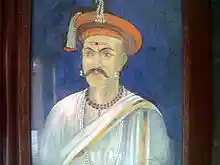The Peshwas come to power
We have heard the word Peshwas in numerous tales, the stories of Bajirao Mastani, the early life of Rani Lakshmibai and many more. But who exactly were these Peshwas? What areas they ruled and how did they come into power?

Shivaji, the great warrior; Image source: Swarajya
The existence of the power of Peshwas traces back to the Great Maratha Empire. There’s only one name that comes to mind when one thinks of the Maratha Empire and that is Chatrapati Shivaji, the warrior of the warriors, the one ruler that completely exhausted Aurangzeb while he lived.
Aurangzeb’s life had become one tiring dance, trying to capture the Maratha Empire and more importantly trying to capture Shivaji. One day on a ruse of a negotiation meeting, he called Shivaji to the Mughal palace. Aurangzeb was not a great follower of the saying ‘Atithi Devo Bhava,’ for he imprisoned Shivaji when he came to meet him. However, Shivaji managed to escape the prison and was on a run his entire life trying to defeat the Mughal ruler.
The mighty warrior’s efforts bore fruit for his people. He managed to defeat the Mughal forces and recapture the forts he had previously lost. However, with the death of Shivaji in 1680, the Mughal army easily dominated the Maratha power which was led by his son Sambhaji. His son Sambhaji along with his wife and son, Sahu was captured by Aurangzeb. Aurangzeb killed Sambhaji through brutal torture sparing his wife and son, for the purpose of future negotiations.
The Maratha’s next in line ruler was held captive, which is why Sambhaji’s brother, Rajaram took the throne and after his death, his wife Tarabai took over as the regent for her minor son, Shivaji II. Now here comes the strategy part. Aurangazeb died in 1707 and the throne after gruesome conflicts was taken over by Bahadur Shah I. Turns out, sparing Sahu, the grandson of Shivaji worked greatly in his favour. He decided to release Sahu. But why did this sudden change of heart happen?
It was not particularly a move out of goodness rather he wanted to instigate some internal conflict in the remaining Maratha forces to weaken them. His strategy worked. The current regent ruler Tarabai and Sahu began their dispute on who was the real ruler. Whose claims would emerge victoriously?
In this confrontation, one man emerged as the most important functionary. This man was Peshwa Balaji Vishwanath, the founder of the Peshwa lineage. He held such an important place in the Maratha court that once he decided in favour of Sahu, Sahu was recognized as the Maratha King!
Peshwa was basically a title that was given to the Prime Minister in the Maratha court. We will see how the meaning of Peshwa would be altered by Balaji Vishwanath. Vishwanath was a very capable prime minister for Sahu. He managed to secure Sahu’s right to collect Chauth ( one-fourth of the total revenue assessment) and Sardeshmukhi (10% levy of revenue) as being the overlords of the Deccan from the Mughals.
Now for how he founded the Peshwa lineage; Balaji managed to get the Peshwa title to be hereditary in nature! That means the next Peshwa (Prime Minister) would come from his bloodline only. Now instead of being post title, the Peshwa title became the surname of his family carried by them for ages to come.
We will see how Peshwas of Poona emerged as one of the main five houses of the Maratha and how their influence, power and recognition grew, overshadowing the actual Maratha clan in the future.

Balaji Vishwanath; Image source: Wikipedia


